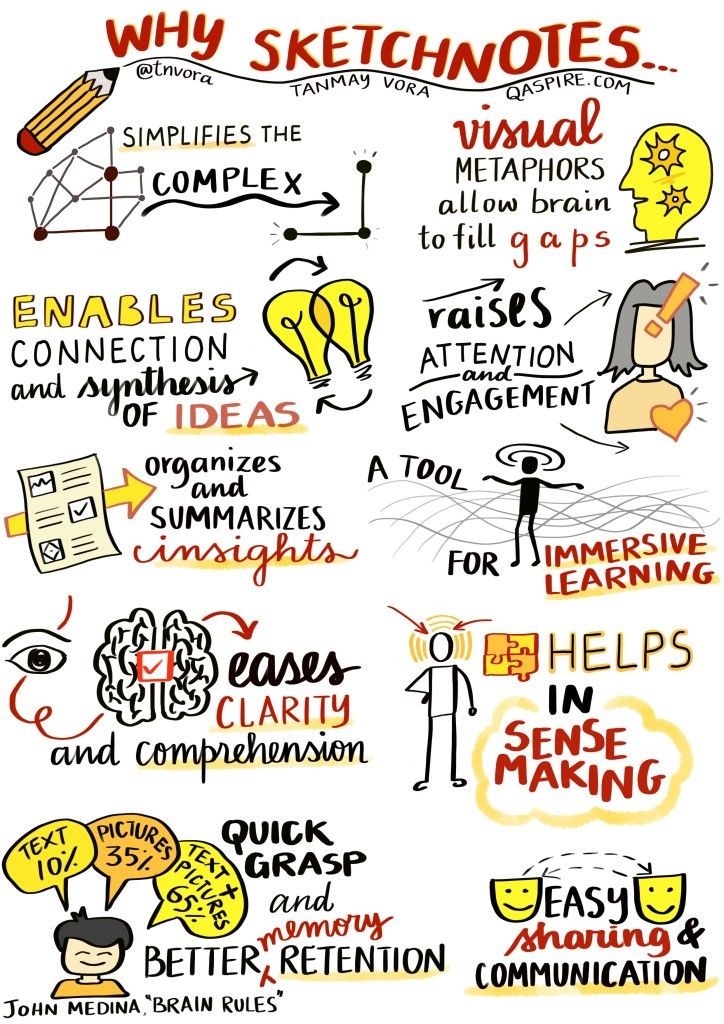
Sketchnote Sceptic?
Visual thinking skills and the creation of visually engaging outputs are becoming more popular and prevalent. Is this a valuable business skill, or a forgettable fad?
What Are Sketchnotes?
The technique was defined and developed by Mike Rohde, and is closely related to other visual disciplines such as graphic recording, visual meeting facilitation and rich pictures.
Sketchnotes combine words and visual elements, to create a record or convey information. The visual elements might include simple sketches, icons and borders. The textual elements can be words or sentences, and make use of different fonts, styles, size and direction. Sketchnotes can be created digitally and by hand – or a combination of both.
The Case Against
Attention seeking?
Sketchnotes often grab our attention, but information filtered through someone else’s brain may arouse more questions than answers. “It’s interesting to see what someone else has learned, but is it helping me learn anything?” The usefulness of other people’s sketchnotes is very variable.
It’s for creative-types!
The professional sketchnote images we see can make us feel inferior. “I wouldn’t know where to start” and “I can’t draw” seem like valid barriers to trying this technique.
All the stuff
As with most aspects of our lives, there are a lot of options. This can translate to what feels like a lot of decisions to make, and “I don’t have the right pens/software/tablet…” can lead to an outcome of ‘do nothing by default’.
Really Listening
People speak quicker than we can write (or draw). If we are concerned about creating an attractive output, this might mean we miss something.
The Case For
Attention seeking?
There is no obligation to share our sketchnotes. We can all experiment with sketchnoting free from the pressures of other people’s opinions. The time may come when we create something to be proud of, and would genuinely be of use to others, but equally the notes are personal and do not have to make sense to anyone else.
It’s for creative-types!
The fact that professional photographers publish beautiful images does not stop the rest of us of using our phone cameras! Creativity is a skill that can be practiced and improved, not a set aspect of personality. We don’t need permission to try something creative, even if it’s outside our usual approach.
All the stuff
Though it would be tempting to believe the right equipment and software would take significant investment of time and money, the reality is that we have everything needed to try it. A pen, some paper, and something to learn or remember.
Really Listening
With the growing amount of virtual input – TED Talks, webinars, online events, remote meetings, we can easily become distracted or attempt to ‘multi-task’. Sketchnoting provides a mechanism to give our full attention to the situation at hand. Distilling the key messages is easier with sketchnoting than traditional notes!

Source: qaspire.com. Image reproduced with permission.
Sketchnote Skills
Listening and comprehension skills are more important than drawing skills for creating great sketchnotes.
People often use visual imagery when speaking, mention anecdotes and use metaphors. By picking out these visual clues, we can enrich the linear verbal information to create a connected visual record. Learning a very small number of icons can build the confidence to add images to notes.
Conclusion
Sketchnotes provide a lasting record of personal development activities; including books, events and training. Over time this builds to a library of knowledge we will be happy to revisit, to reactivate and refresh the learning.
If we let go of the desire to be perfect, and the narratives we tell ourselves about ‘not being creative’ and ‘no good at art’, we can move away from the ubiquitous pages of text and bullet points. We can create engaging outputs that help us remember more, synthesise information and make connections.
Resources
Mike Rhode, The Sketchnote Handbook (2012)
https://rohdesign.com/sketchnotes-1
http://qaspire.com/sketchnotes/
https://graphicsmadeeasy.co.uk/